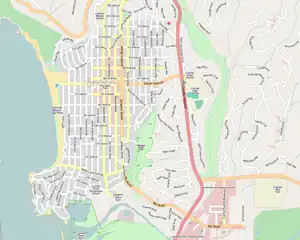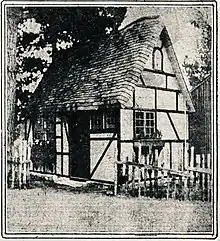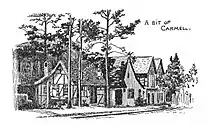| Carmel Weavers Studio | |
|---|---|
 Carmel Weavers Studio | |
| Location | Ocean Avenue, Carmel-by-the-Sea, California |
| Coordinates | 36°33′20″N 121°55′24″W / 36.55556°N 121.92333°W |
| Built | 1922 |
| Built by | Lee Gottfried |
| Built for | Ruth Kuster |
| Original use | Weaving studio and ticket booth |
| Current use | Retail store |
| Architect | Edward G. Kuster |
| Architectural style(s) | Tudor Revival |
 Carmel Weavers Studio Map of Carmel-by-the-Sea | |
The Carmel Weavers Studio, also known as Cottage of Sweets, is a historic building in Carmel-by-the-Sea, California. It was built in 1922 for Ruth Kuster as a studio, that was in front of the Golden Bough Theatre. It forms an important component of the "Court of the Golden Bough" shopping center. The studio qualified for inclusion in the city's Downtown Historic District Property Survey, and was registered with the California Register of Historical Resources on January 27, 2003.[1] The building is occupied by the Cottage of Sweets.
History


The Carmel Weavers Studio is a one-story, plaster and wood-framed Tudor Revival English cottage with a steep pitched side-gabled roof and exterior stucco wall with half-timbered framing. Carmel stone flower planters are at the base of the building in front on Ocean Avenue and Monte Verde Street behind a Carmel stone court. The studio was built in September 1922 by Lee Gottfried for Ruth Kuster, the wife of lawyer and theatrical producer Edward G. Kuster.[1][2] It housed her and two fellow local weavers, with their looms and spinning wheels. They made and sold woven scarves, hats, handbags, blankets, and other clothing articles.[3][4]
In July 1923, the studio was rolled down on logs from Dolores Street to be included in Kuster's "Court of the Golden Bough" on Ocean Avenue, to be included with several other shops. In August 1923, Gottfried expanded the studio with a design by Kuster that included a tall exterior clinker brick chimney and a ticket booth for the Theatre of the Golden Bough. At the same time, construction of Kuster's Seven Arts Shop was being planned as another shop for the courtyard. Kuster would have Gottfried build Sade's on the northeast side of the court in 1925.[1][5][6][7]
Carmel Weavers Studio was one of the shops designed by Kuster's to contribute to the layout of the "Court of the Golden Bough" shopping area. Perry Newberry praised the "artistic shops," and advocated for the nomination of Kuster to Carmel's Hall of Fame in his July 1, 1927 editorial. “He’s the one man responsible for the building of unique and different shops in Carmel.” Newberry went on to say, “When Kuster began, in 1923, to design the plans for his Little Theatre, he also designed at the same time a group of artistic shops...They met with public approval, apparently, for it was not long after this until there were other little shops here that made Carmel known. So, instead of white front wooden buildings that are characteristic of every small town in the west, Kuster's dream has changed our Main Street into an Ocean Avenue of beauty and artistry."[8]
Historical Status
The Carmel Weavers Studio has qualified for inclusion in the Downtown Historic District Property Survey and the California Register of Historical Resources as it is one the early commercial shops designed and funded by Edward G. Kuster, and was built to compliment the Golden Bough Theatre.[1]
In 1959, Walter "Wally" Cullomore, from British Columbia, Canada bought the shop and turned it into the Cottage of Sweets. In 1980, Lanny & Linda Rose took over the business and kept if for 39 years before selling it to Hans Hess and his family.[9]
See also
References
- 1 2 3 4 Kent L. Seavey (January 27, 2003). "Carmel Historic Survey Volume II blocks 70 end plus historic districts". Department of Parks and Recreation. Retrieved April 4, 2022.
- ↑ "Ocean Avenue to Have Another New Building". Monterey Daily Cypress and Monterey American. Monterey, California. 13 Sep 1922. p. 1. Retrieved April 7, 2022.
- ↑ "The Weavers of Carmel". Oakland Tribune. Oakland, California. 19 Nov 1922. p. 64. Retrieved April 4, 2022.
- ↑ Hudson, Monica (2006). Carmel-By-The-Sea. Carmel-by-the-Sea, California: Arcadia Publishing. p. 84. ISBN 9780738531229. Retrieved 2022-04-16.
- ↑ Hale, Sharon Lee (1841). A Tribute to Yesterday: the History of Carmel, Carmel Valley, Big Sur, Point Lobos, Carmelite Monastery, and Los Burros. Carmel-by-the-Sea, California: Valley Publishers. p. 65. ISBN 9780913548738. Retrieved 2022-04-04.
- ↑ Dramov, Alissandra (2019). Historic Buildings of Downtown Carmel-by-the-Sea. Carmel-by-the-Sea, California: Arcadia Publishing. p. 77. ISBN 9781467103039. Retrieved 2022-04-04.
- ↑ Seavey, Kent (2007). Carmel, A History in Architecture. Carmel-by-the-Sea, California: Arcadia Pub. p. 74. ISBN 9780738547053. Retrieved 2022-04-04.
- ↑ "Kuster To Build 16 Shops". Carmel-by-the-Sea, California: Carmel Pine Cone. January 25, 1946. pp. 1, 16. Retrieved January 13, 2024.
- ↑ Elaine Hesser (June 15, 2012). "A Cottage That's For History Buffs As Well As Chocolate Lovers" (PDF). Carmel Pine Cone. pp. 12, 25. Retrieved April 4, 2022.